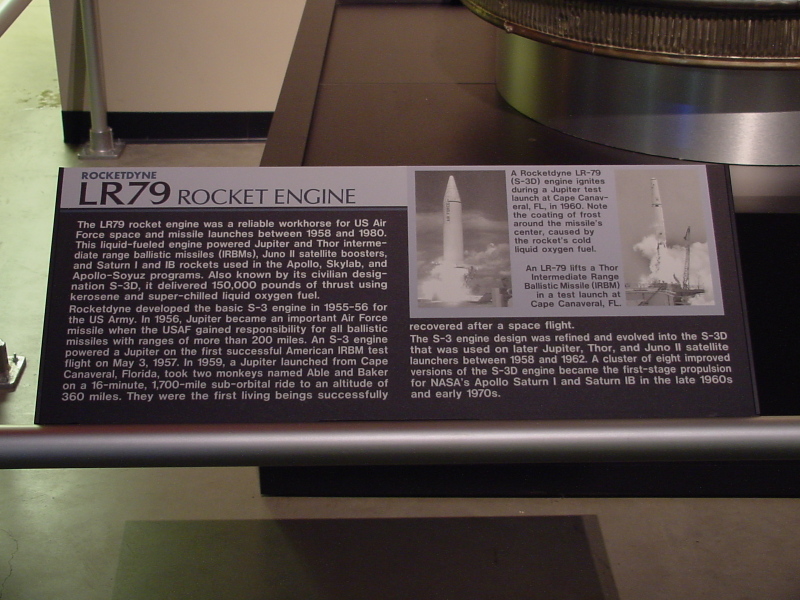| Prev |
heroicrelics.org Air Force Museum Site Index S-3D/LR-79 Engine Gallery |
Next |
dsc15610.jpg
The sign accompanying the engine. It reads
Rocketdyne LR79 Rocket Engine
The LR79 rocket engine was a reliable workhorse for US Air Force space and missile launches between 1958 and 1980. This liquid-fueled engine powered Jupiter and Thor intermediate range ballistic missiles (IRBMs), Juno II satellite boosters, and Saturn I and IB rockets used in the Apollo, Skylab, and Apollo-Soyuz programs. Also known by its civilian designation S-3D, it delivered 150,000 pounds of thrust using kerosene and super-chilled liquid oxygen fuel.
Rocketdyne developed the basic S-3 engine in 1955-56 for the US Army. In 1956, Jupiter became an important Air Force missile when the USAF gained responsibility for all ballistic missiles with ranges of more than 200 miles. An S-3 engine powered a Jupiter on the first successful American IRBM test flight on May 3, 1957. In 1959, a Jupiter launched from Cape Canaveral, Florida, took two monkeys named Able and Baker on a 16-minute, 1,700-mile sub-orbital ride to an altitude of 360 miles. They were the first living beings successfully recovered after a space flight.
The S-3 engine design was refined and evolved into the S-3D that was used on later Jupiter, Thor, and Juno II satellite launchers between 1958 and 1962. A cluster of eight improved versions of the S-3D engine became the first-stage propulsion for NASA's Saturn I and Saturn IB in the late 1960s and early 1970s.
This sign seems to try to take a bit too much credit; the S-3D was uprated and substantially simplified to create the H-1 rocket engine which powered the Saturn I and Saturn IB rockets.
Also, the Jupiter was an Army missile, developed by Wernher von Braun's team at the Redstone Arsenal as a follow-up to the Redstone missile. The Air Force didn't want the Jupiter, which had similar performance and capabilities as the Thor missile that they were developing. A 1956 decision by the Secretary of Defense ordered that the Air Force would be responsible for all missiles with a range in excess of 200 miles.
Development on Jupiter was well ahead of Thor, so development on both missiles was continued to ensure that the U.S. would have at least one IRBM (should either the Army or Air Force run into difficulties). Eventually, a commission was formed to decide which missile would survive and be deployed. The Soviets launched Sputnik before the commission could render a decision, and in the post-Sputnik panic, it was decided that both missiles would be deployed.

| Time picture taken | Sat Oct 29 12:42:30 2005 |
| Location picture taken | Missile/Space Gallery Air Force Museum Dayton, OH |
| Prev | S-3D/LR-79 Engine Gallery | Next |